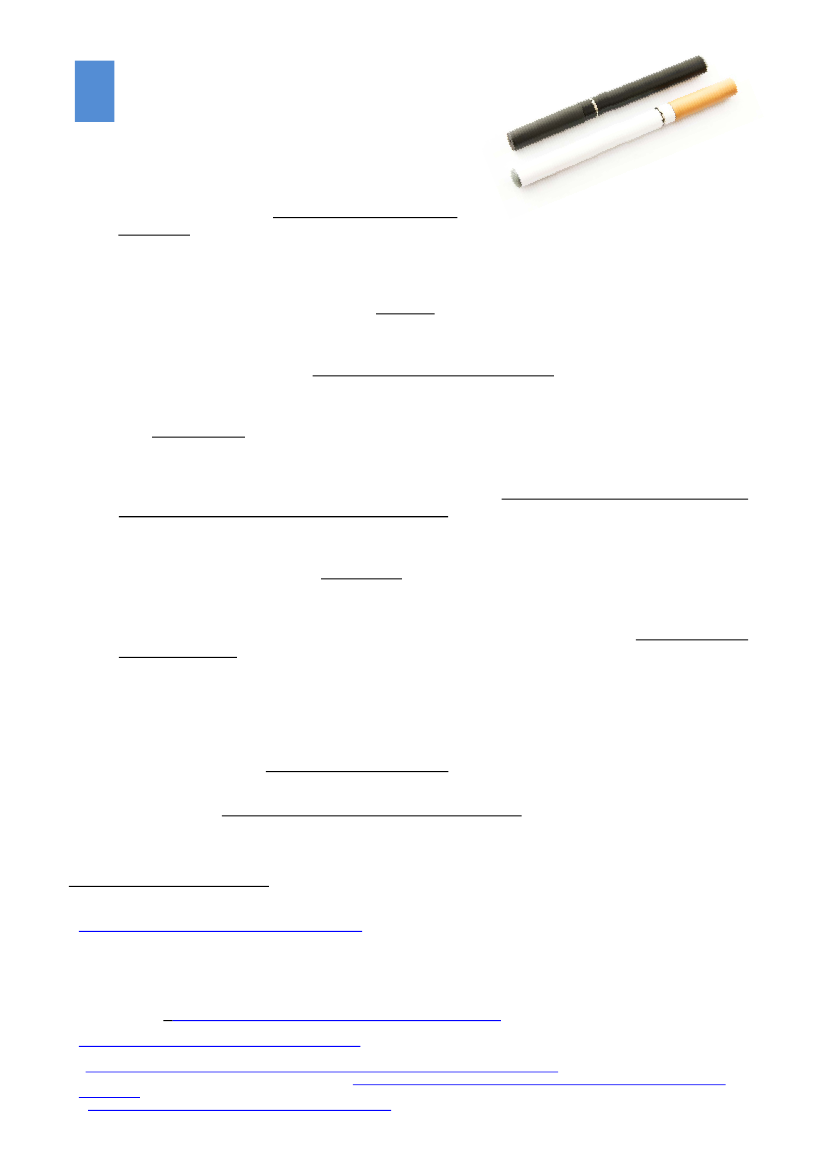
E-CIGARETTES
Current Regulation
•
Currently there is no EU wide regulatory
framework to guarantee the safety and quality of
e-cigarettes. The application of the General Product Safety Directive is not sufficient.
1
Concentration and Size
•
•
An e-cigarette with a concentration of 20mg/ml delivers approx. 1 mg of nicotine in 5 minutes
(the time needed to smoke a traditional cigarette, which delivers 1mg of nicotine).
2
The most commonly sold strength of e-cigarettes is 17-18 mg/ml
3
and strengths of 20mg/ml
and lower were shown to be effective for the majority of smokers in their cessation efforts.
4
Cartridges and Refills
•
The market share for refillable cartridges and tanks varies across the EU. At this stage
reliable independent studies on market shares are not available. A recent study of a
stakeholder estimated the EU average of refillable e-cigarettes to slightly exceed 40%.
5
Refillable cartridges and refill bottles
6
with liquid can be contaminated, expose users to toxic
nicotine liquid
7
and are a safety risk for children.
8
These products also allow users to home
blend higher nicotine strengths and flavour combinations.
The majority of products on the market consists of disposable e-cigarettes and e-cigarettes
with sealed cartridges. These limit the risk that users come into contact with nicotine liquid.
9
•
•
Flavours
•
•
Regulating flavours is important to ensure that products are not attractive to young people
and non-smokers (risk of gateway into nicotine addiction
et alia).
Flavours currently in use in nicotine replacement therapies include tobacco (approx. 50% of
the e-cigarette market), mint, fruit, lemon, toffee and liquorice.
10
Uniform Dosing
•
•
Users should receive consistent nicotine delivery when they use an e-cigarette.
11
Devices should be designed to ensure that the same puff, for example 5 seconds consuming
0.003ml liquid, always delivers the same amount of nicotine.
14 notifications concerning (refill) liquids for E-cigarettes via the RAPEX system have been reported. DG Health and Consumers. Rapid
Alert System for non-food products posing a serious risk (RAPEX) Brussels: DG SANCO; 2012.
http://ec.europa.eu/consumers/safety/rapex/index_en.htm
2
Farsalinos et al. Evaluation of Electronic Cigarette Use (Vaping) Topography and Estimation of Liquid Consumption. Int J Environ Res
Public Health. 2013;10: 2500-14.
3
Information from industry and the MHRA for UK market.
4
Farsolinos et al. Evaluating nicotine levels selection and patterns of electronic cigarette use in a group of ‘Vapers’ who had achieved
complete substitution of smoking. Substance Abuse: Research and Treatment. 2013; 7:139-146.
5
Provided by industry. Estimates based on research conducted in UK, FR, DE, PL, IT, ES. In comparison, the market share in the US is
approximately 10%.(http://www.cspdigitals.com/msa/MSA_CSP_Content_092613.pdf)
6
The commonly sold 10ml refill bottle of 18mg/ml liquid contains the equivalent of 180 smoked tobacco cigarettes.
http://www.totallywicked-eliquid.co.uk/about-the-fluid.html
7
Regulation (EC) No 1272/2008, OJ L 353.
8
http://www.jpost.com/Breaking-News/Toddler-who-ingested-liquid-nicotine-passes-away-314683.
In the view of the BfR, refill solutions in
particular pose an additional health hazard for children (http://www.bfr.bund.de/en/frequently_asked_questions_about_e_cigarettes-
130598.html).
9
http://www.e-cigarette-forum.com/infozone/Dr-Lynne-Dawkins
10
Survey of MS (BE, DE, EE, ES, FI, HR, HU, IE, LT, LV, SI, SK and UK) on authorised flavours. Information from industry.
11
“Analyses of nicotine levels delivered from electronic cigarettes suggest significant variability exists in the products tested to date.”
(http://www.mhra.gov.uk/home/groups/comms-ic/documents/websiteresources/con286839.pdf).
1